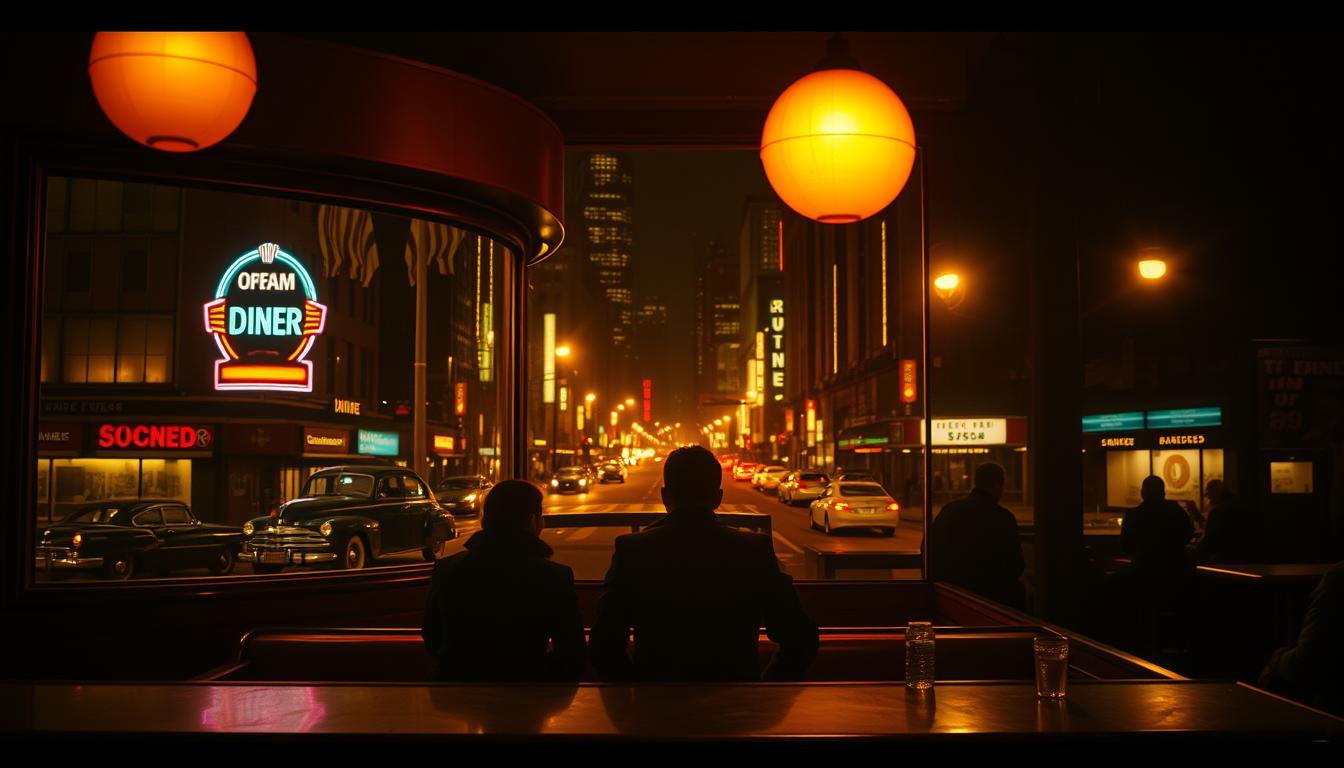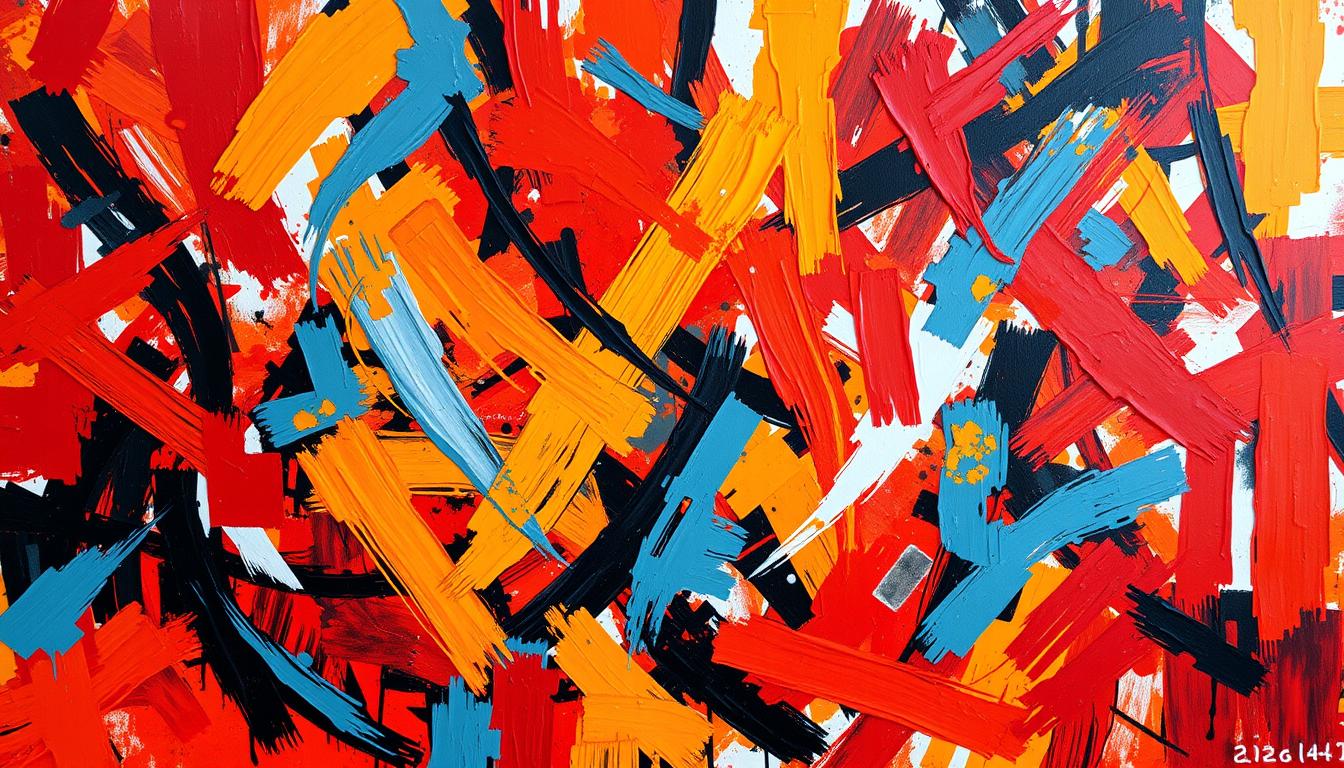What makes a quiet diner glow into an icon? Edward Hopper’s 1942 oil captures four figures in a downtown diner at night. The large glass window and the diner’s light spilling onto empty streets create a cinematic, readable scene that draws the viewer into an instant story.
The work landed at the Art Institute of Chicago within months for $3,000 and then became a landmark of american art. Its restrained palette, measured geometry, and precise staging turn an ordinary urban moment into a lasting study of mood and place.
Hopper once said he was "painting the loneliness of a large city." That line helps explain why the image moved beyond galleries into the wider world. The contrast between the bright diner and the dark street invites every person who looks to imagine what came before and after.

Key Takeaways
- Edward Hopper’s work uses simple composition to create lasting emotion.
- The Art Institute’s early purchase helped secure public access and fame.
- The night-lit diner and empty street form a universal urban scene.
- The painting blends New York specificity with broad relatability.
- Its fame rests on mood, storytelling, and visual clarity across the world.
Inside Edward Hopper’s world: the artist, the era, and American Realism
Edward Hopper shaped quiet city moments into scenes that feel both real and staged. He worked within American Realism, making believable places the subject rather than mythic figures. His approach gave modern art a steady, documentary calm.
Edward Hopper’s vision of New York City life
The artist watched New York City with a careful, cinematic eye. He loved the movies; film framing taught him to arrange light, shadow, and a small cast of figures like a still from a scene. That training made his works read as mysteries rather than dramatized tales.
American Realism and the modern city’s loneliness
Hopper’s paintings often show a few people in public places, each private despite proximity. Critics note his focus on urban isolation, and he admitted, in his own words:
“Unconsciously, probably, I was painting the loneliness of a large city.”
In the early 1940s, storefronts, empty streets, and late-night counters became stages for reflection. In the context of american art, Hopper’s honest portrayal of city life gave his works lasting cultural weight.
| Aspect | Characteristic | Effect on the viewer |
|---|---|---|
| Composition | Sparse, cinematic framing | Focuses attention, creates narrative tension |
| Light | Isolated pools against dark streets | Heightens mood and psychological space |
| Figures | Few, distanced, everyday people | Suggests private thought within public life |
| Context | Early 1940s New York | Reflects wartime pause and urban rhythms |
For further background on the work and its display history, see this concise entry at the Art Institute link: Edward Hopper’s Nighthawks.
The painting at a glance: medium, size, date, and museum home
Measured details — medium, date, and size — explain how the image asserts itself in a room.
Oil on canvas, 1942, 33.1 × 60 in: bigger than you think
This oil on canvas was completed on January 21, 1942. The work measures about 33.1 by 60 inches (84.1 × 152.4 cm), a scale that feels more commanding in person than in print.
From gallery to the Art Institute of Chicago for $3,000
Hopper recorded the working title Night Hawks in his notes. The painting debuted at Rehn’s Gallery and, on May 13, 1942, Daniel Catton Rich bought it for the Art Institute of Chicago for $3,000 (roughly $57,730 in 2024).
Why this matters: the Art Institute’s early purchase placed the piece in a major museum American collection, giving generations regular access and helping the artist’s work enter schoolrooms and public life.
Technically, the diner’s bright light pushed Hopper to test zinc white to capture the glow; he later returned to lead white after cracking appeared. The combination of medium, scale, and crisp light helps the composition read clearly across a gallery and in reproduction.
What you’re seeing: composition, lighting, and the famous diner window
A broad, curved window frames the counter and customers as actors on a small public stage. The uninterrupted glass keeps the viewer outside, making the interior read like a staged image and the street a dark, passive audience.
The sweeping glass, counter, and corner geometry
The corner placement gives the composition a diagonal thrust. The arc of the counter and the line of stools guide the eye from the foreground toward the four figures.
Details anchor the scene: a cherry wood counter, jade-green tiles, and the Phillies 5¢ cigar sign add urban texture and realism.
Fluorescent light and tight color choices
Fluorescent lighting creates a hard, even glow that spills onto the pavement. Hopper tested zinc white to capture that luminance; later pigment shifts responded to cracking.
Warm interior hues sit against cool exterior darkness. That contrast makes the light feel inviting and isolating at once.
| Element | Notable feature | Effect |
|---|---|---|
| Window | Full, curved plate-glass | Displays interior; keeps viewer outside |
| Counter | Cherry wood arc with stools | Guides eye; encloses figures |
| Lighting | Fluorescent glow, zinc white tests | Hard interior light; strong street contrast |
| Figures | Four people, spaced and angled | Near-encounters; psychological tension |
In short: composition and light work together. The curved glass and counter contain the scene, while the lighting turns a simple diner into a charged, memorable image in the painting.
Themes that resonate: Why is Nighthawks painting so famous?
Under the diner’s glow, small gestures hint at larger, unspoken lives. The scene reads like a pause in a story, inviting the mind to finish what the canvas leaves undone.
“Loneliness of a large city”: being alone together
Loneliness threads through the composition. Hopper’s own line about "painting the loneliness of a large city" frames how the works ask us to feel the gap between people in public places.
Wartime tension and empty streets
Painted after the U.S. entered WWII, the piece carries wartime anxiety. Blackout drills and post‑Pearl Harbor unease gave New York nights a brittle, watchful quality that deepens the painting loneliness reading.

Stories held in one frame
The absent door and the glass barrier make the viewer complicit in the distance. A man and a woman almost reach; hands and gazes suggest longing without closure.
Because the diner at night is a universal symbol, the image travels beyond its city. Its spare props and few figures let a single framed moment carry a full sense of life and fear. For more context on Hopper’s era and reception, see Hopper's context explained.
These intertwined themes — war, night, glass, and silence — help this image speak to the world, keeping its narrative grip alive for each new generation.
From sketch to canvas: sources, models, and the name “Night Hawks”
Jo Hopper’s notebooks map the slow build from idea to finished canvas. Her journal records the completion date, Jan 21, 1942, and the intended title Night Hawks.
Jo’s notes and the studio storyboards
As his wife and keeper of records, Jo made sketches and short notes that track each step. Edward prepared many storyboards and studies to test timing, angles, and character placement.
Literary and art echoes
Gail Levin linked this work’s suspended mood to Hemingway’s "The Killers" and to Van Gogh’s Café Terrace at Night, which hung in New York in January 1942. Exposure to that image likely fed Hopper’s nocturnal imagination.
Models, the “beak” detail, and the studio mirror
Jo described a “night hawk (beak)” look for the man at the counter. She also wrote that Edward posed for the male figures using a mirror while she posed for the woman. That domestic staging grounded the scene in lived detail.
| Source | Evidence | Effect on final work |
|---|---|---|
| Jo Hopper’s journal | Completion date; title note; sketches | Anchors timeline and original name |
| Storyboards & sketches | 19 preparatory drawings shown at the Whitney Museum of American Art | Refines composition and timing |
| Literary/visual influences | Hemingway; Van Gogh’s night café | Shapes mood and nocturnal light |
“Night hawk (beak)”
The careful lead-up—from studies to pigment choices—makes the final work read as effortless. For a concise overview of the piece and its reception, see this contextual entry at Edward Hopper at Art in Context.
Where is the diner? Greenwich Avenue myths, two streets, and a composite city
Local maps and Hopper’s notes point toward Greenwich Avenue, yet the corner refuses a single, neat address. He wrote that the idea came from a restaurant on greenwich avenue “where two streets meet,” then added that he simplified and enlarged what he remembered.

“Where two streets meet”: Greenwich Village inspiration
The artist’s line gives locals a clear starting place. Many listeners then named Mulry Square (the junction of Greenwich Ave, Seventh Ave South, and West 11th St).
Mulry Square debate and the case for an amalgam of places
Records complicate that theory: the lot often held a gas station in the mid‑20th century, not a diner. Scholars now favor a composite view.
| Claim | Evidence | Likely source |
|---|---|---|
| Mulry Square | Local tradition; corner geometry | Memory + map fit |
| 11th Street storefront | Glass-and-steel façades in photos | Visual detail in preparatory sketches |
| Crawford Lunch & Flatiron curve | Historical restaurant mentions; curved corners | Combined memories shaped final scene |
Whether a single block or an edited fold of new york streets, the large continuous window and missing door matter more than the exact address. Hopper used city fragments to build a corner that feels both particular and universal.
Instant classic to pop‑culture icon: how Nighthawks conquered the world
A swift museum purchase and eager critics turned a quiet diner scene into an instant classic. In 1942 Daniel Catton Rich called the work “fine as a Homer” when he bought it for the Art Institute, and that early endorsement fast‑tracked its reach into museum american circles and schoolrooms.
Film, set design, and cinematic echoes
Critics link the composition to film noir, and directors have borrowed its mood and light for decades. Ridley Scott famously waved a reproduction on set while shaping Blade Runner’s future‑noir look.
Homages, parodies, and a shared visual language
Artists and musicians answered the call: Helnwein’s Boulevard of Broken Dreams, Banksy’s fractured window riff, Red Grooms’s crowded Nighthawks Revisited, and Tom Waits’s album Nighthawks at the Diner all rework the diner counter and late‑night atmosphere.
Gail Levin and other scholars note how the suspended action in the work echoes modern literature and keeps the image alive across media. Reproductions on posters, shirts, and murals show that one painting can become a common cultural code from New York to small town Canada.
Conclusion
, A single lit corner can hold a whole city’s questions. Edward Hopper shaped a scene through patient study: Jo’s notes, Whitney Museum sketches, and careful pigment choices gave the canvas clarity. That disciplined method helped the art find its power.
The diner and its counter frame four quiet figures. The woman and man, the absent door, the contrast of light and dark let viewers supply the rest. The Art Institute’s early purchase spread the image across New York and beyond, making the work central to american art.
Today artists echo that mood, and the painting’s mix of exact detail and open space keeps inviting imagination. Its balance of craft, timing, and humane observation makes this late‑night scene feel like a mirror for modern life.
Enhance Your Space with Unique Modern Masterpieces
Are you inspired by the innovative mediums and conceptual depth highlighted in our exploration of contemporary art? You’re not alone! Today’s art enthusiasts are seeking cultural relevance and emotional connections in their artwork. However, finding pieces that resonate with modern themes and fit your unique style can be a challenge. That’s where we come in!
At Rossetti Art, we specialize in canvas prints, original paintings, and modern sculptures that celebrate the spirit of now. Each piece created by Chiara Rossetti brings a personal touch that connects deeply with current social narratives—just like the modern masterpieces discussed in the article. Don’t miss out on the chance to elevate your home decor with breathtaking artwork that speaks to your values and aesthetic. Explore our collection today and find your perfect piece! Act now, and transform your space into a gallery of inspiration!
FAQ
What makes Edward Hopper’s Nighthawks stand out in American art?
Hopper combined clean composition, cinematic lighting, and everyday subject matter to create a scene that feels both specific and universal. The diner’s glass window, the spare counter figures, and the sharp artificial light form a visual story that invites viewers to imagine lives beyond the frame. Museums, critics, and filmmakers embraced the work, helping it enter public imagination as a symbol of modern urban solitude.
How did Hopper’s life and the era shape this image?
Working in the 1930s and 1940s, Hopper responded to American Realism and the modern city’s tension. He painted quiet moments in New York with attention to architecture, light, and mood, reflecting both personal observation and broader cultural anxieties of wartime America. His wife Jo kept notes and posed as a model; their collaboration informed his intimate studies of everyday places.
What are the painting’s medium, size, date, and current home?
Painted in oil on canvas in 1942, the work measures roughly 33.1 by 60 inches. The Art Institute of Chicago acquired it shortly after completion, and the museum’s early purchase helped cement the piece’s reputation in the canon of American modern art.
Where did Hopper find the visual details for the diner scene?
Hopper drew on sketches, city walks, and memories of New York. He blended elements from Greenwich Village and other corners of the city into a composite setting rather than depicting a single real storefront. Jo Hopper’s notes and his preparatory drawings reveal how he refined the sweeping glass window, counter placement, and figures to achieve the final composition.
Why is the diner window so important in the composition?
The large glass pane creates a frame within a frame. It separates the interior’s artificial light and human intimacy from the deserted, dark street outside. That boundary turns the viewer into a silent observer and heightens the painting’s emotional distance and narrative tension.
What role does lighting and color play in the scene?
Hopper used cool street tones against warm interior light to create contrast and mood. Fluorescent-like illumination flattens details inside the diner while casting deep shadows outside. These choices direct attention to the figures and the counter, building a cinematic stillness that feels both immediate and unresolved.
How do themes like loneliness and wartime anxiety appear in the work?
The painting captures the paradox of being together yet apart: people share a space but appear isolated. Created during World War II, the scene reflects a city on edge—late hours, empty streets, and a sense of suspended action. That emotional resonance helped the picture speak to broad audiences and endure over time.
Did any literary or art figures influence Hopper’s approach?
Writers and painters informed Hopper’s choices. Ernest Hemingway admired pared‑down realism, and earlier artists like Vincent van Gogh explored nocturnal interiors. Hopper absorbed such influences but translated them into his unique American scenes, prioritizing stillness and architectural clarity over narrative resolution.
Is there a real diner that inspired the painting’s location?
Hopper often combined places. Greenwich Village and spots near Mulry Square get cited as inspirations, but scholars argue the image is an amalgam rather than a literal address. That ambiguity adds to the work’s mythic quality—viewers project personal memories onto the scene.
How did the work move from critical success to pop‑culture icon?
Early acclaim and the Art Institute’s acquisition gave it institutional weight. Filmmakers and photographers borrowed its aesthetic for film noir and science fiction, while contemporary artists and musicians referenced it in homages and parodies. Its striking visual language—diner, glass, night, solitary figures—proved endlessly adaptable across media.






Leave a comment
This site is protected by hCaptcha and the hCaptcha Privacy Policy and Terms of Service apply.